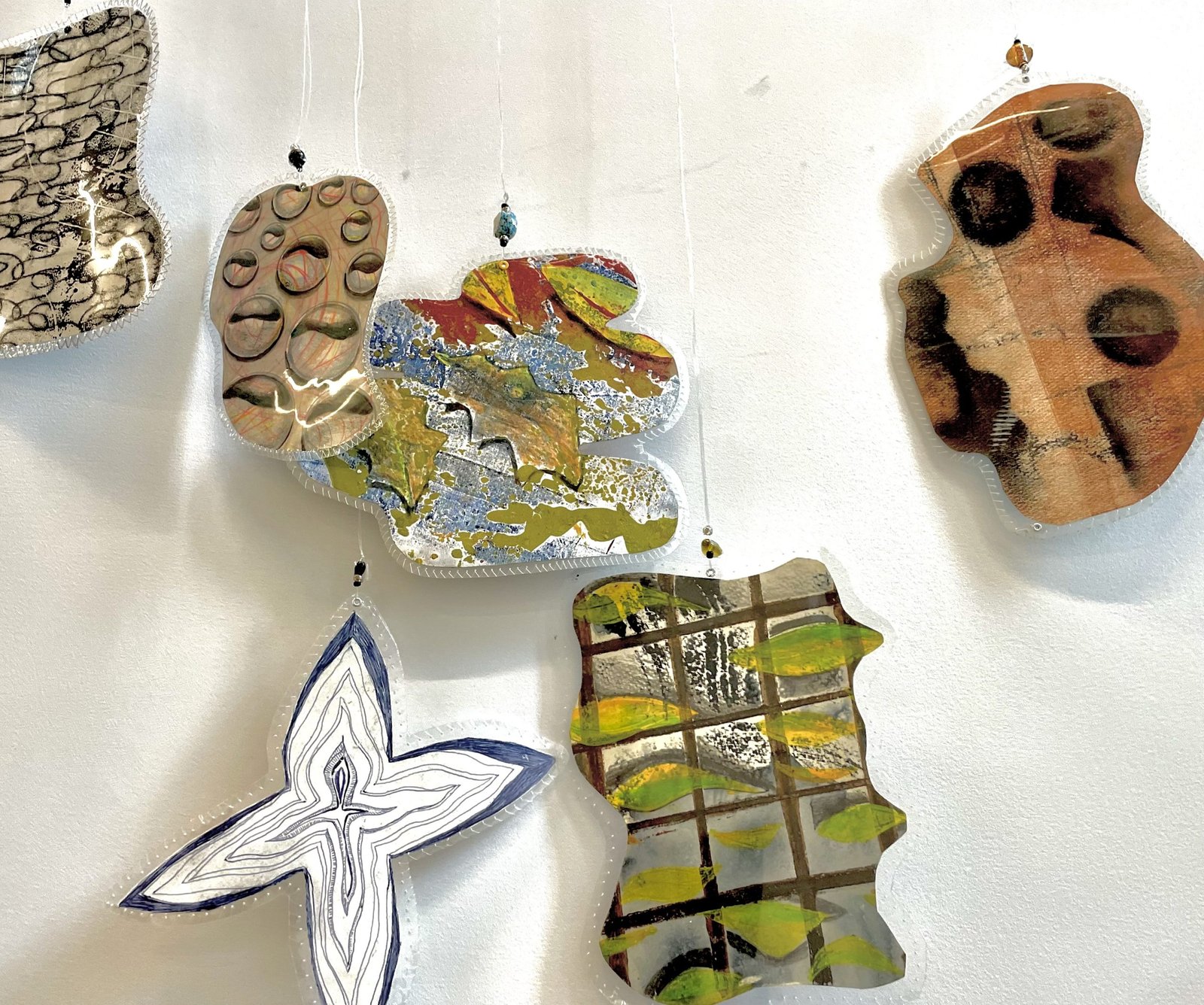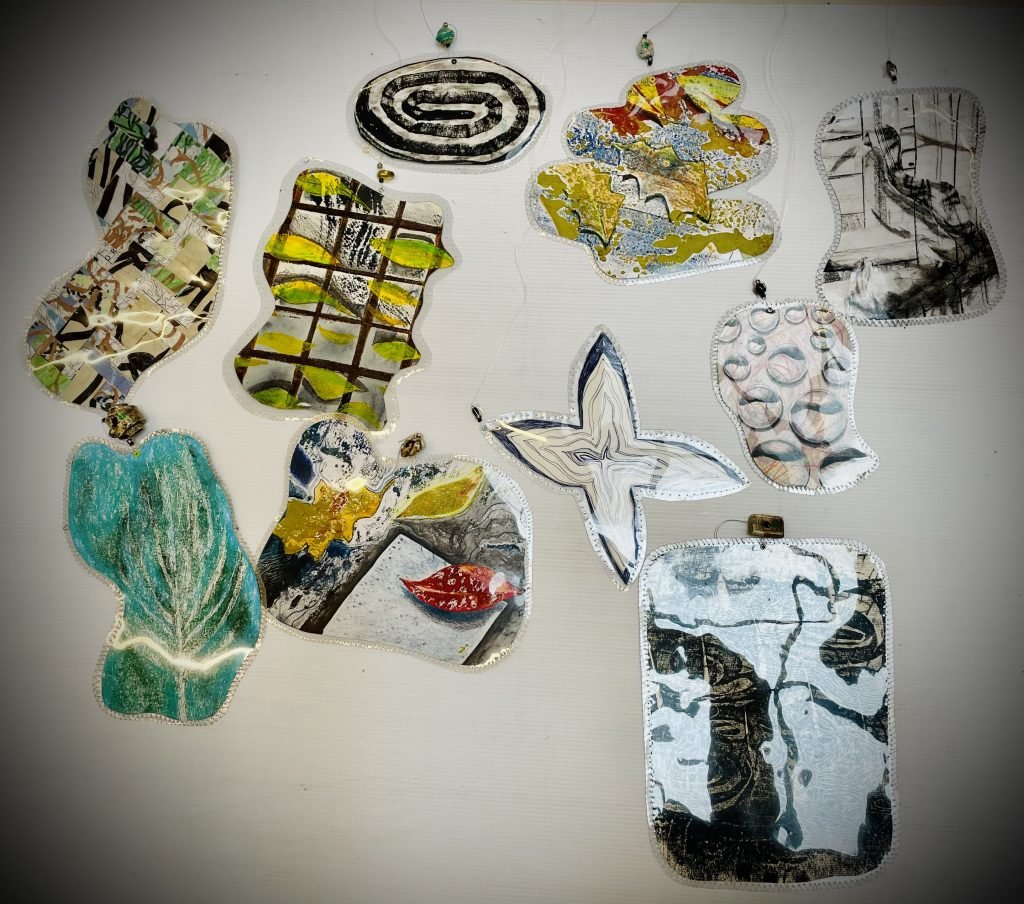
vancouver rain
vancouver rain
sherida charles
june 1 - june 30, 2023
ccbc shop & gallery
artist statement
In creating these pieces, I experience drawing as an ongoing process, a physical object, and an embodied abstract concept, as opposed to a framed document with an illusion of reality. The artistic process is a filter for observed and ‘felt’ reality, an attempt to recreate glimpses, moments, sensations, and the transience of moving through my environment. This space, whether suburban, urban or even rural, is marked by interaction with weather; in Vancouver or on the west coast, this frequently means rain.
The overall premise of the installation is to allow the viewer to experience drawing and mark making in novel ways. Expanding the drawing process to include multiple viewpoints, motion, irregularity, negative space, intuition, and the suggestion of inspiration beyond the literal are all factors in the construction of this idea. The drawings and monoprints are encased and handsewn into transparent sleeves to contain and protect them. The idea evolved from seeing how other artists have re-imagined traditional media such as sculpture so I wanted to apply a similar process to the act of drawing. A major influence on this work has come from the work of Beatriz Milhasz, a Brazilian artist who uses hanging work and abstract painting, and closer to home, Jenny Judge, with her sculptural installations. Having the pieces hanging allows for spinning and changing views. The use of beads is meant to add weight and enhance this motion. With some of the works I have used ceramic beads I made; in others, I used ‘found’ beads from my costume jewellery collection. A green identifying tag on the bead indicates I made it and a yellow one indicates a ‘found’ bead.


As part of the process, embracing spontaneity and uncertainty became key. It was important to me to work regularly without predetermining the results or where the work would end up or how it would be presented. I didn’t “overthink” the creation of these small drawings. Each one could be completed in a relatively tight time frame, before or after or in stages during the work day. I wanted to avoid rectangular formats which tend to suggest mark direction and content, so I pre-cut the paper into an irregular shape or cut it after some spontaneous beginnings and worked back into it. I used whatever materials were on hand—-pencil, pen, ballpoint, conté, charcoal, pastels, pencil crayons, ink pens, steel brush, sharpie—-without discrimination, just relishing what each tool could convey and often layering and working with contrasting media or approaches on the reverse sides. Monoprints were spontaneously produced as well, using trace monoprinting, ink removal with tools, stencils and splatters and scraping with a variety of implements, and then cut, backed and drawn into after they dried. Weavings were made with cuttings from old prints, drawings, and scrap paper and drawn into as well. As more got done it felt to me like much of the abstract imagery referenced raindrops on windows, wet leaves on pavement, or tar squiggles on the sunlit roads. These impressions in my head as I transit through the city or the countryside—waves, branches, tree forms and cloud patterns—-all surfaced during the spontaneous drawing process.
The challenge of figuring out how to preserve and show these pieces was considerable. I went through a few iterations, from within a frame, to hanging from a cloud shaped structure, which did inspire the “rain” idea more concretely. The use of plastic duralar sleeves evolved from a desire to use rigid plexiglass and create standing notched forms; this proved a lot more technical than I felt able to accomplish, especially during Covid….so I used plastic sheeting I could easily cut myself and added the sewing when the spray adhesive wasn’t holding them together firmly enough. During the sewing process the meditative nature of the project became more prominent in my mind, along with the idea that I was taking it into a fibre realm and feeling more like historical “woman’s work” and part of a wider craft tradition. All along the way, I was inventing ways to make these function, and solving problems that arose as I went. The project as a whole is definitely outside my comfort zone and not the way I have traditionally worked, but these are the parts of it that made it so intriguing and compelled me to keep going.

Any references the audience sees in the works are relevant; the imagery and effects should be enjoyed as experienced, without preconceived ideas. I hope viewers embrace the surprise of unique shapes, marks, tones, textures; of double-sided drawings, of motion, changing space and associations or interconnections between the pieces, of knowing that not everything needs to be “named” or described in words. Drawing has a language and ‘speaks’ to us in visual and tactile ways. I hope viewers experience the unusual cast reflections that the works send out when hit by sunshine; the unexpected ethereal beauty of this was my greatest reward in making these pieces and installing them. The overarching ‘idea’ of rain fits the way these works are hung and viewed and links them to our west coast locale, but it should not limit the ways the works can be viewed or interpreted.
sherida charles (she/her) is a Jamaican-born Canadian, public school teacher, and member of Printermedia, a collaborative Printmaking studio in Vancouver. Sherida gratefully acknowledges the traditional territories of the Qayqayt, Squamish, Musqueam and Tsleil-waututh Nations on which she resides and works. She received her BFA from UBC (’86) and a diploma in Visual Arts from the Banff Center (’87), and has exhibited work in Vancouver, Banff, Kingston, (Jamaica), Brooklyn, and New Westminster. In 2022, Sherida exhibited in two local venues was nominated for “Artist of the Year” in New Westminster. She enjoys working in print, drawing, paint and mixed media. With her drawing, she focusses on experimental mark-making, monoprinting and multimedia layering, motivated by a keen interest in pushing the limits and accessibility of the medium. Underlying these recent expressive works is a growing interest in composition, abstraction, and simplification presented in innovative ways using unconventional media.
